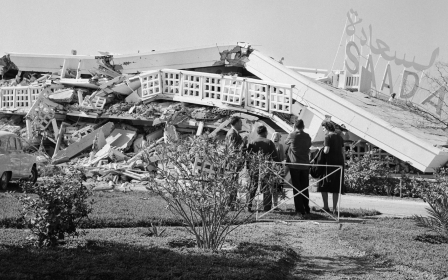Morocco earthquake: Historic and tourism sites severely damaged

The deadly 6.8-magnitude earthquake that struck Morocco late on Friday has claimed over 2,500 lives and levelled large parts of rural villages.
It has also caused damage to popular tourism sites.
While the focus has been on the human toll of the devastating quake, many are also lamenting the loss of cultural heritage sites.
Images of damaged mosques, traditional homes and other ancient sites, including in the famous old city of Marrakech, began to be circulated on social media hours after the tremors hit.
Tourism has become vital to the kingdom's economy, and in the first half of this year the number of tourists arriving rose by 92 percent compared with the same period of 2022.
Stay informed with MEE's newsletters
Sign up to get the latest alerts, insights and analysis, starting with Turkey Unpacked
Middle East Eye takes a look at some of the historic sites that have sustained damage or been largely destroyed in the quake.
Mosques and minarets
Jemaa el-Fnaa Mosque, situated on the famous Marrakech square of the same name, dates back to the 14th century and appears to have sustained heavy damage. Images following the earthquake show its minaret completely levelled.
The nearby Kutubbiya Mosque, dating back to the 12th century, was also partially damaged. However, the extent of the damage is still being assessed. The mosque had recently been renovated and fitted with energy-efficient lights and solar panels.
People have raised concerns over the mosque’s famous 69-metre-high minaret, from which dust was billowing out following the tremors. Some media reports state that it has suffered substantial cracks.
Both mosques are situated in Marrakech's old city, a Unesco world heritage site.
Another mosque that has been heavily impacted by the shockwaves is the Tinmel Mosque, which is located close to the epicentre of the quake in the High Atlas mountains.
The mosque, which dates back to the early 12th century, was built by Abd el-Mumin, the first caliph of the Almohad caliphate, an Amazigh empire that stretched across the Maghreb. It is an important example of Almohad architectural heritage.
Images show the Unesco world heritage site has suffered significant damage, with some walls reduced to rubble. Its tall minaret has largely been destroyed.
Overlooking the Valley of Ouirgane, Tinmel Mosque was built to commemorate Mehdi Ibn Toumert, the founder of the Almohad movement who used Tinmel as his base for the conquest of Marrakech in 1147.
Marrakech's medieval Medina and red walls
Marrakech's old city, also known as the Medina, has been listed as a Unesco world heritage site since 1985. Popular among tourists, the area has many buildings that date back to the 11th century. The 700-hectare area is renowned for its labyrinth of narrow alleyways.
Historically, this area was a key political, economic and cultural hub. Its influence was felt around the region.
In recent years the old city has attracted a large number of tourists, who come to see the old souqs and stay in ancient riad hotels.
One of the most iconic features of the Medina is its distinctive red walls. Many of its buildings and the city's walls have sustained heavy damage.
Jewish quarter
One of the worst-hit areas is the ancient Jewish quarter, also known as the mellah.
AFP reported survivors describing the area as if “it was hit by a bomb” and recalled how roofs of buildings were collapsing.
The Jewish presence in Morocco dates back as far as the 4th century BCE, with many but not all Jews living in mellahs in cities from the mid-1500s. Marrakech's mellah is a separate, walled-off part of the city, and hosts several antique buildings and features, including the Slat al-Azama Synagogue, which is believed to be around 500 years old.
Today, the mellahs are almost entirely empty of Jews, as Morocco's Jewish community was hollowed out in the 20th century by emigration to Israel and Europe, particularly France.
Fortified cities
Morocco's stunning landscapes have attracted production crews for several high-budget films, particularly in the city of Ouarzazate, south of the High Atlas mountains.
Some of the films shot in the city include Lawrence of Arabia (1962), The Mummy (1999), Salmon Fishing in the Yemen (2011) and the TV series Game of Thrones.
The area has suffered some destruction, with people sharing photos on social media of traditional clay houses shattered and reduced to rubble.
People are also mourning the loss of other important historical sites online.
The Unesco-listed Ksar Ait Ben Haddou, an ancient fortified group of dwellings located on the route between the Sahra and Marrakech, is where parts of Lawrence of Arabia were shot, and has also been affected in the quake.
Other popular tourist destinations, such as the city of Amizmiz, have been heavily damaged, with the residents now seeking shelter in makeshift tents.
Unesco’s director-general, Audrey Azoulay, who is of Moroccan Jewish descent, issued a statement on Saturday expressing solidarity with the Moroccan people and emphasising the need to assess the damage to the sites.
Middle East Eye delivers independent and unrivalled coverage and analysis of the Middle East, North Africa and beyond. To learn more about republishing this content and the associated fees, please fill out this form. More about MEE can be found here.




